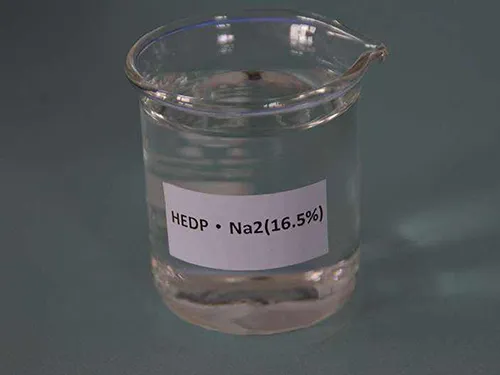Eco-Friendly Scale Inhibitors: The Role of Organic Phosphonates
In modern industries, efficient water treatment systems play a crucial role in maintaining operational efficiency and reducing environmental impact. Organic phosphonates, such as PBTC tricarboxylic acid, HEDP Na2, and HEDP Na4, have become integral components in addressing scaling and corrosion challenges. These compounds not only enhance system longevity but also support sustainable practices by minimizing waste and pollution.

Understanding the Chemistry of PBTC Tricarboxylic Acid
PBTC tricarboxylic acid (2-phosphonobutane-1,2,4-tricarboxylic acid) is a widely used organic phosphonate known for its excellent scale inhibition properties. Its molecular structure allows it to chelate with calcium, magnesium, and other scaling ions, effectively preventing crystal growth. This makes PBTC highly effective in water systems prone to high mineral content.
Industries value PBTC tricarboxylic acid for its stability under high temperatures and wide pH range. This adaptability ensures that the compound remains effective in demanding environments such as cooling towers, boilers, and oilfield operations.
Organophosphonates: Versatile Solutions for Water Treatment
The broader category of organophosphonates encompasses compounds like HEDP Na2 and HEDP Na4, each offering distinct advantages. These compounds are not just scale inhibitors but also serve as corrosion inhibitors by forming protective films on metal surfaces. This dual functionality makes them invaluable in industries where equipment integrity is critical.
HEDP Na2, the disodium salt of hydroxyethylidene diphosphonic acid, is particularly effective in stabilizing metal ions and preventing their precipitation. Its sodium-based formulation enhances its solubility, making it ideal for systems with varying operational conditions.
On the other hand, HEDP Na4, the tetrasodium salt variant, offers greater flexibility in blending with other water treatment agents. Its high pH tolerance makes it suitable for alkaline water systems, ensuring comprehensive protection against scale and corrosion.
The Role of PBTC and HEDP in Environmental Sustainability
As industries strive for greener operations, the use of PBTC tricarboxylic acid, HEDP Na2, and HEDP Na4 aligns with sustainability goals. These organic phosphonates are biodegradable and exhibit low aquatic toxicity, making them environmentally friendly alternatives to traditional scale and corrosion inhibitors.
For example, PBTC is recognized for its low threshold inhibition, which means even minimal dosages can deliver significant performance. This reduces chemical consumption and minimizes the environmental impact of water treatment processes. Similarly, the biodegradability of HEDP Na2 and HEDP Na4 ensures that treated water discharged into the environment meets stringent regulatory standards.
Applications of PBTC and HEDP in Industrial Systems
The versatility of PBTC tricarboxylic acid and HEDP salts makes them suitable for a wide range of applications. In cooling water systems, PBTC prevents the buildup of scale deposits, ensuring efficient heat transfer and reducing energy consumption. Meanwhile, HEDP Na2 and HEDP Na4 provide corrosion protection, extending the lifespan of pipelines, heat exchangers, and other equipment.
In oilfield operations, these organophosphonates are used to treat injection water and prevent scale formation in downhole equipment. Their ability to perform under high pressure and temperature conditions makes them indispensable for maintaining productivity in challenging environments.
Choosing the Right Organic Phosphonate for Your Needs
Selecting the most suitable organic phosphonate depends on the specific requirements of your system. For high-temperature or alkaline conditions, PBTC tricarboxylic acid and HEDP Na4 are excellent choices due to their stability and broad operational range. If solubility and compatibility with other chemicals are priorities, HEDP Na2 is a reliable option.
Additionally, a combination of these compounds can provide synergistic effects, enhancing overall system performance. By consulting with water treatment specialists, industries can develop tailored solutions that address their unique challenges while aligning with environmental regulations.
The use of organic phosphonates, including PBTC tricarboxylic acid, HEDP Na2, and HEDP Na4, represents a significant advancement in water treatment technology. These compounds offer effective scale and corrosion inhibition, support sustainable practices, and ensure compliance with environmental standards. By integrating these innovative solutions into their operations, industries can achieve improved efficiency, reduced maintenance costs, and a smaller environmental footprint. Whether in cooling towers, boilers, or oilfields, organophosphonates are paving the way for a cleaner and more sustainable future in water treatment.
-
Understanding Polycarboxylic Acids: Properties, Applications, and Future PotentialNewsJul.28,2025
-
Scale Inhibitor Explained: How to Protect Your System from Limescale and Hard Water DamageNewsJul.28,2025
-
Scale and Corrosion Inhibitors: Essential Chemicals for Industrial Water System ProtectionNewsJul.28,2025
-
Polyaspartic Acid: A Biodegradable Polymer for Sustainable ChemistryNewsJul.28,2025
-
Isothiazolinones: A Versatile Antimicrobial Class with Industrial Power and Regulatory ChallengesNewsJul.28,2025
-
A Deep Dive into 2-Phosphonobutane-1,2,4-Tricarboxylic Acid (PBTC)NewsJul.28,2025





